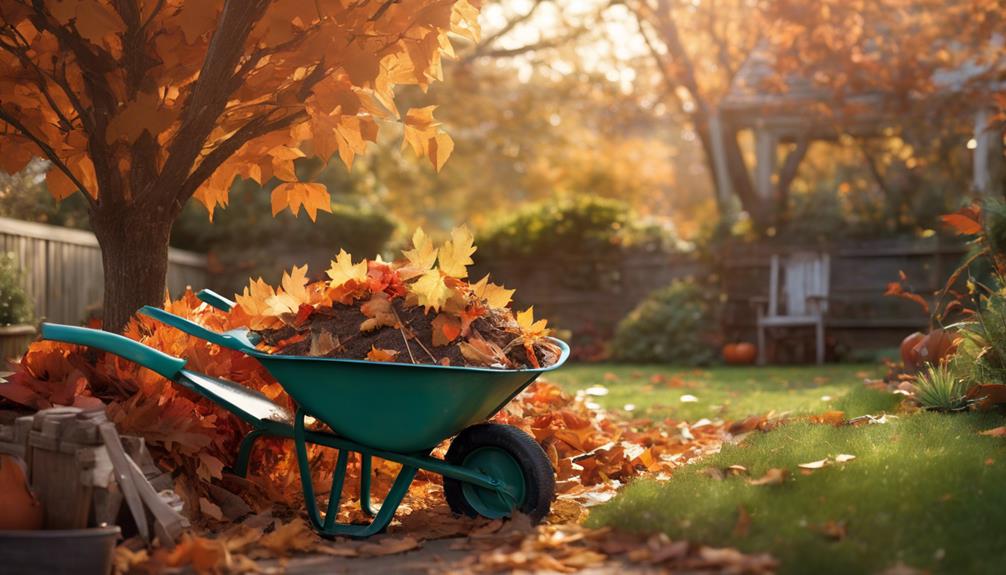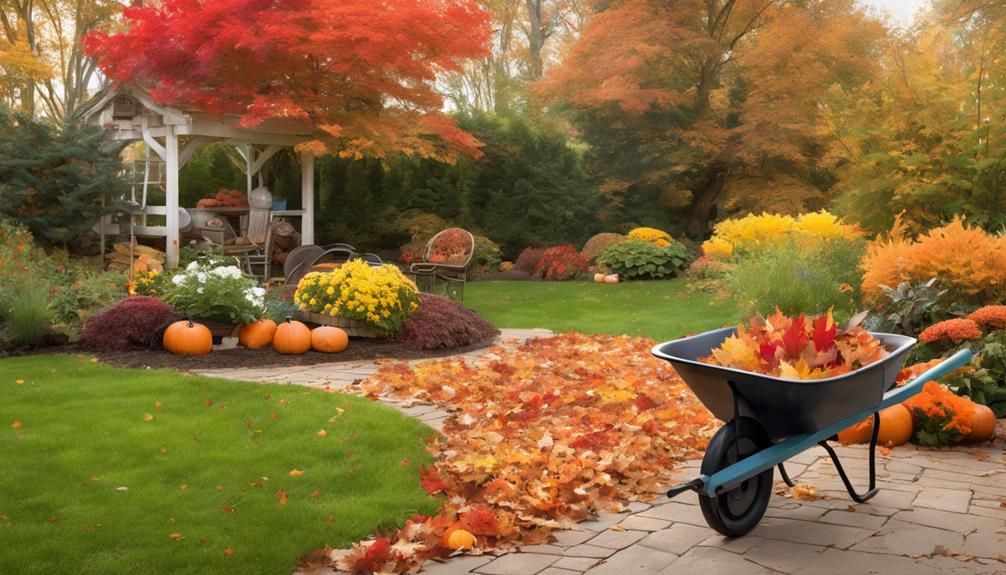
7 Best Low-Maintenance Plants for Your Garden
2 February 2025Pressure Washing: Benefits for Your Garden’s Health
2 February 2025Choosing budget-friendly autumn garden cleanup tips is crucial for maintaining a thriving garden without overspending.
These strategies utilise fundamental tools and sustainable practices that not only streamline the cleanup process but also enrich the soil. Techniques such as composting fallen leaves and reusing organic materials greatly reduce waste while enhancing soil fertility.
By implementing these cost-effective methods, gardeners can promote healthier plants and minimise expenses.
Moreover, adopting practical cleanup strategies ensures that gardens are well-prepared for winter, setting the stage for a fruitful spring.
Exploring these strategies can lead to greater gardening success and financial savings.
Seasonal Garden Maintenance Essentials
Effective seasonal garden maintenance requires the right tools to facilitate efficient clean-up.
Investing in essential gardening implements can streamline the process, making it easier to manage fallen leaves and debris.
Furthermore, composting autumn leaves not only reduces waste but also enriches the soil for future planting.
Tools for Efficient Cleanup
Efficiency in garden cleanup hinges on having the right tools at your disposal. Crucial instruments include a sturdy rake for gathering leaves, which allows for swift accumulation without damaging the lawn.
A reliable pair of pruning shears is important for trimming perennials and removing dead foliage, ensuring your plants' health for the forthcoming season. Furthermore, a robust garden cart facilitates the transport of debris, minimising the effort involved in disposal.
Consider investing in a durable tarpaulin to collect and haul away larger quantities of waste efficiently. Finally, gloves are indispensable for protecting your hands while you work.
Composting Autumn Leaves
Autumn leaves often present a challenge for gardeners, yet they can be transformed into a valuable resource through composting. By collecting fallen leaves, gardeners can create nutrient-rich compost that improves soil quality and promotes healthy plant growth.
To effectively compost leaves, shred them to accelerate decomposition and mix them with green materials, such as kitchen scraps and grass clippings. This balance of carbon and nitrogen is essential for a successful compost heap.
Additionally, maintaining adequate moisture levels and turning the heap regularly will expedite the breakdown process. Ultimately, composting autumn leaves not only reduces waste but also provides an economical and sustainable method to enrich your garden, ensuring a robust soil ecosystem for the upcoming planting season.
Cost-Effective Cleanup Strategies
Implementing cost-effective cleanup strategies can significantly enhance your autumn gardening experience while keeping expenses manageable.
By mulching with organic materials, composting kitchen scraps, and efficiently reusing fallen leaves, gardeners can create a sustainable environment that benefits both their plants and their budget.
These practices not only reduce waste but also enrich the soil, promoting healthier plant growth for the forthcoming seasons.
Mulching With Organic Materials
Regularly mulching with organic materials is an excellent cost-effective strategy for autumn garden cleanup. This method not only improves soil health but also suppresses weeds and retains moisture during the colder months.
By selecting the right organic materials, gardeners can create a sustainable environment that benefits their plants.
- Straw: Provides excellent insulation and reduces soil erosion.
- Wood chips: Decomposes slowly, offering long-term benefits while suppressing weeds.
- Leaves: A readily available resource that enriches the soil as they break down.
- Grass clippings: Adds nitrogen to the soil while serving as a protective layer.
Incorporating these organic materials into your autumn garden routine can greatly reduce costs while promoting a thriving ecosystem.
Composting Kitchen Scraps Efficiently
Composting kitchen scraps efficiently is a practical approach to reducing waste while enhancing garden health. By transforming organic materials into nutrient-rich compost, you cultivate a sustainable gardening practice that minimises costs.
To optimise the benefits of your composting efforts, consider the following strategies:
- Balance greens and browns: Incorporate a mix of nitrogen-rich greens (vegetable scraps) and carbon-rich browns (dry leaves, cardboard) for ideal decomposition.
- Chop scraps: Cutting kitchen scraps into smaller pieces accelerates the breakdown process, facilitating quicker compost creation.
- Maintain moisture: Ensure your compost pile is adequately moist, resembling a damp sponge, to promote microbial activity.
- Aerate regularly: Turning the compost pile every few weeks improves airflow, enhancing decomposition and preventing unpleasant odours.
Implementing these techniques will yield rich compost, elevating your garden's health efficiently.
Reusing Fall Leaves Efficiently
As autumn cloaks the landscape in vibrant hues, homeowners often face a common dilemma: what to do with the abundance of fallen leaves.
Instead of discarding these natural resources, consider creative methods for reusing them effectively. Employing these strategies not only enhances your garden but also proves to be budget-friendly:
- Mulch: Shred leaves and apply them as mulch to suppress weeds and retain soil moisture.
- Compost: Incorporate leaves into your compost heap to enrich nutrient content.
- Leaf Mould: Create leaf mould by moistening leaves and allowing them to decompose, resulting in a valuable soil amendment.
- Wildlife Habitat: Pile leaves in corners of your garden to provide shelter for beneficial wildlife.
Through these methods, fallen leaves become assets rather than burdens.
Practical Cleanup Techniques
As the autumn season approaches, it is crucial to assess your garden's needs to ensure a successful transition into winter.
Conducting soil tests can provide valuable insights into nutrient balance, helping to inform your next steps.
Furthermore, incorporating cover crops can significantly improve soil health, setting the stage for a productive garden in the spring.
Assess Your Garden's Needs
Regularly evaluating your garden's needs is crucial for effective autumn cleanup and preparation for the upcoming season.
By appraising specific requirements, you can prioritise tasks and implement strategies that enhance the garden's health and aesthetics.
Consider the following key points:
- Identify plant health: Inspect for any signs of disease or pest infestations that may require immediate attention.
- Evaluate soil condition: Look for compacted areas, erosion, or nutrient deficiencies that could hinder plant growth.
- Examine plant placement: Determine if any plants are overcrowded or poorly situated, which may affect their performance next season.
- Plan for seasonal changes: Consider the impact of winter conditions on your garden layout and decide on protective measures as needed.
This thorough evaluation guarantees a well-organised and productive autumn cleanup.
Soil Testing for Nutrient Balance
Following an assessment of your garden's needs, soil testing becomes a crucial step towards ensuring the perfect nutrient balance.
This process allows you to identify nutrient deficiencies and excesses, enabling informed decisions about amendments. Conducting soil tests can be straightforward and cost-effective, providing insights vital for optimal plant growth.
- Determine pH levels for effective nutrient availability
- Analyse macronutrient and micronutrient content
- Identify soil texture and drainage capabilities
- Monitor organic matter levels for comprehensive soil health
Cover Crops for Soil Health
Incorporating cover crops into your autumn garden cleanup routine serves as an effective strategy for improving soil health.
These plants not only enhance soil structure but also contribute to nutrient cycling and pest management. By selecting the appropriate cover crops, you can create a sustainable ecosystem that supports future plant growth.
Consider the following benefits of cover crops:
- Erosion Control: Reduce soil erosion during the winter months.
- Nutrient Fixation: Leguminous cover crops, such as clover, enrich the soil with nitrogen.
- Weed Suppression: Dense cover crop growth inhibits weed development.
- Soil Aeration: Root systems improve soil porosity, enhancing water infiltration.
Implementing cover crops will yield long-term benefits, making your garden more resilient and productive in subsequent growing seasons.
Enhanced Soil Fertility
Enhanced soil fertility is vital for a flourishing garden, particularly as you prepare for the autumn season. Implementing cost-effective practices can significantly improve soil quality, ultimately leading to healthier plants. Techniques such as adding compost, using organic fertilisers, and employing mulching can increase nutrient availability without putting a strain on your budget.
| Practice | Benefits |
|---|---|
| Composting | Boosts microbial activity |
| Organic Fertilisers | Provides slow-release nutrients |
| Mulching | Retains moisture and suppresses weeds |
| Crop Rotation | Prevents nutrient depletion |
Seasonal Planting Techniques
As the autumn season approaches, implementing effective seasonal planting techniques can optimise your garden's productivity.
Strategies such as starting seeds indoors, transplanting perennials, and applying autumn fertilisers are crucial for preparing your garden for the colder months.
These practices not only improve plant health but also ensure a thriving garden come spring.
Seed Starting Indoors
Starting seeds indoors can be a rewarding experience for gardeners looking to get a head start on the growing season. This technique not only saves money but also allows for better control over growing conditions.
To successfully start seeds indoors, consider the following crucial tips:
- Select Appropriate Containers: Use seed trays or biodegradable pots to promote healthy root development.
- Provide Adequate Light: Utilise grow lights or a sunny window to ensure seedlings receive sufficient light for robust growth.
- Monitor Temperature and Humidity: Maintain ideal temperatures and humidity levels to encourage germination.
- Use Quality Seed-Starting Mix: Employ a sterile, well-draining mix to minimise disease risk and promote healthy growth.
Transplanting Perennials in Fall
The shift into autumn presents an ideal opportunity for gardeners to embrace the art of transplanting perennials. As temperatures cool and moisture levels rise, plants are better positioned to establish roots before winter.
Successful transplanting requires attention to detail and timing to ensure robust growth in the coming spring. Consider these vital tips:
- Choose the right time: Aim for early autumn, ideally four to six weeks before the first frost.
- Select healthy specimens: Opt for perennials that show no signs of disease or stress.
- Prepare the new site: Amend the soil with organic matter to improve drainage and fertility.
- Water thoroughly: Ensure deep watering post-transplant to promote root development.
Fall Fertilizer Application Techniques
After successfully transplanting perennials, attention turns to the crucial practice of autumn fertiliser application. This significant step not only nurtures root development but also prepares the garden for winter.
Employing effective techniques ensures ideal nutrient absorption and plant health.
- Choose a slow-release fertiliser to provide a steady supply of nutrients throughout the autumn.
- Conduct a soil test to determine specific nutrient needs and avoid over-fertilisation.
- Apply fertiliser after the first frost to prevent stimulating new growth that could be damaged by the cold.
- Water thoroughly post-application to facilitate nutrient uptake and minimise fertiliser burn.
Pest Control During Cleanup
Effective pest control during garden cleanup is vital for maintaining a healthy landscape.
Employing invasive weed removal techniques can prevent pests from establishing a presence, while companion planting offers a natural method to deter unwanted insects.
Furthermore, utilising natural pest deterrents can enhance your garden's resilience without relying on harsh chemicals.
Invasive Weeds Removal Techniques
When tackling garden clean-up in the autumn, addressing invasive weeds is vital for maintaining a healthy landscape.
These aggressive plants can outcompete your desired flora, leading to diminished biodiversity and increased maintenance efforts.
Employ effective removal techniques to ensure their long-term control:
- Manual Removal: Hand-pulling or using a hoe to uproot weeds, ensuring that roots are completely removed.
- Mulching: Applying a thick layer of mulch can suppress weed growth and retain soil moisture.
- Boiling Water: Pouring boiling water directly onto weeds effectively kills them without harming the surrounding soil.
- Vinegar Solution: Using a high-acetic acid vinegar can serve as a natural herbicide for smaller infestations.
Implementing these strategies will help you reclaim your garden and foster a flourishing ecosystem.
Companion Planting for Pest Control
Utilising companion planting as a strategy for pest control can significantly enhance the health and productivity of your autumn garden.
By strategically pairing plants, you can create a natural deterrent against common pests, thereby reducing the need for chemical interventions.
Consider the following effective combinations:
- Marigolds with vegetables: Their scent repels nematodes and aphids.
- Basil planted near tomatoes: This pairing enhances flavour while deterring flies and mosquitoes.
- Nasturtiums grown alongside cucumbers: They attract aphids away from cucumbers, serving as a trap crop.
- Garlic planted around roses: Its pungent aroma can repel pests such as aphids and spider mites.
Incorporating these companion planting techniques not only fosters a healthier ecosystem but also promotes sustainable gardening practices.
Natural Pest Deterrents
As the gardening season draws to a close, maintaining a pest-free environment during cleanup is vital for the health of your garden.
Utilising natural pest deterrents not only protects your plants but also aligns with eco-friendly practices. Here are some effective strategies to consider:
- Neem oil: A natural insecticide that disrupts the life cycle of pests.
- Diatomaceous earth: A powder that damages the exoskeletons of insects, providing a physical barrier.
- Garlic spray: A potent repellent that can deter a variety of pests with its strong aroma.
- Companion herbs: Planting mint or basil can naturally repel unwanted insects.
Implementing these methods during your autumn cleanup will ensure a thriving garden come spring, all while remaining budget-conscious.
Why Choose TKL Birmingham Gardener
Choosing TKL Birmingham Gardener is often a prudent decision for homeowners seeking expert assistance with their autumn garden cleanup.
With a commitment to sustainability and a profound understanding of local horticulture, TKL provides tailored solutions that enhance your garden's health and aesthetics.
Their experienced team employs eco-friendly practices, ensuring that your outdoor space not only flourishes but also contributes positively to the environment.
By utilising techniques that minimise waste and optimise resource efficiency, TKL helps homeowners achieve a pristine garden without incurring unnecessary costs.
Their meticulous attention to detail and dedication to customer satisfaction set them apart, making them a reliable partner in transforming your garden into a vibrant, well-maintained sanctuary for the autumn season.
Common Garden Cleanup Questions
Garden cleanup during the autumn season often raises a variety of questions among homeowners. Common inquiries include the ideal timing for cleanup, the best methods for disposing of debris, and whether to remove perennials.
Homeowners frequently wonder if mulching leaves is beneficial or if they should compost them instead. Furthermore, questions about soil preparation for winter and how to protect plants from frost are prevalent.
Understanding the importance of evaluating plant health before cleanup can also be a concern. Addressing these questions ensures that homeowners can effectively prepare their gardens for the upcoming winter months, fostering a healthier ecosystem and setting the stage for a flourishing spring bloom.
Mastery of these cleanup practices not only improves garden aesthetics but also promotes sustainability.
Plan for Winter Gardening
Planning for winter gardening involves strategic foresight to ensure that your outdoor space remains productive and vibrant during the colder months.
This preparation not only enhances your garden's resilience but also sets the stage for spring growth. To ensure success, consider the following crucial strategies:
- Select cold-hardy crops, such as kale and spinach, which thrive in lower temperatures.
- Implement protective measures, including row covers and mulching, to shield plants from harsh elements.
- Establish a composting plan to enrich soil health for the upcoming growing season.
- Invest in season-extending tools, like cold frames or greenhouses, to prolong your gardening efforts.




